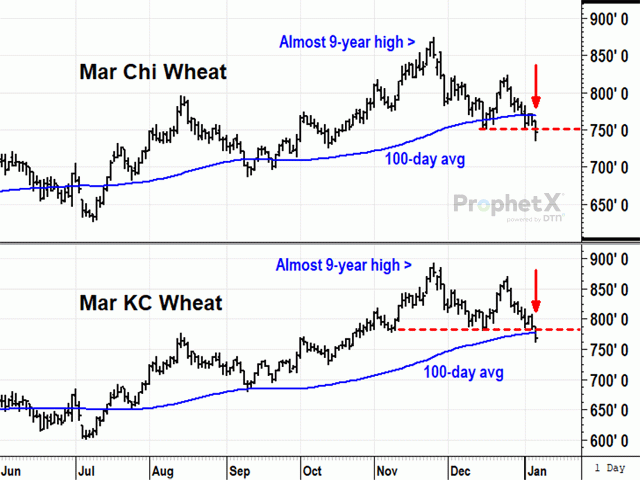Todd's Take
Bearish Week for Winter Wheat Prices
Sometimes markets make sense and sometimes they don't. Trying to distinguish between meaningful moves and nervous volatility is usually helped by an assessment of the market's own clues and fundamental evidence. In the case of winter wheat, I said in many market comments this fall that I expected the lowest U.S. wheat supplies in eight years, keeping prices well supported through winter.
For soft red winter (SRW) wheat in particular, USDA estimated 93 million bushels (mb) of U.S. ending stocks in 2021-22, the second lowest in 14 years. USDA estimated 309 mb of hard red winter (HRW) wheat stocks in 2021-22, the lowest in seven years. As far as new-crop concerns go, the dormant SRW wheat crop is mostly in good shape with plenty of soil moisture available. That's not the case for HRW wheat where drier conditions in the southwestern Plains led to lower crop ratings from state NASS offices on Monday, Jan. 3. The emergence of new U.S. winter crops are still months away and, so far, are not considered a significant bearish threat.
Nevertheless, after spot prices almost reached nine-year highs in November, the expectation of prices staying well supported was challenged in mid-December, as wheat prices fell back but maintained support. An unexpected string of lower closes in the final week of 2021 was the first real warning bell. March corn fell 2% that week, but March KC wheat was down 7%, the largest percentage loss in the grain sector, followed by a 5% weekly drop in March Chicago wheat.
On Wednesday, Jan. 5, March Minneapolis wheat, the most bullish wheat story of 2021, fell below its 100-day average for the first time in over a year. March Chicago and March KC wheats posted their own bearish changes in trends Thursday as both closed at new two-month lows, also below their 100-day averages.
Fundamentally speaking, one of the two main changes in December and early 2022 was the successful southern harvests in Australia and Argentina, now adding another 1.43 billion bushels (bb) or more of wheat to the world's exportable supplies. The other change has been a growing awareness of dismal U.S. wheat exports in 2021-22. Thursday's (Jan. 6) weekly report revealed a paltry 1.8 mb of export sales in the final week of 2021, a new marketing-year low.
P[L1] D[0x0] M[300x250] OOP[F] ADUNIT[] T[]
While the two are admittedly bearish influences, I suspect they weren't the only reasons the uptrends in all three U.S. wheats broke lower this week. One of the most difficult aspects of tracking a bull market is knowing when end-user buying is exhausted.
As we saw for corn and soybeans earlier in 2021, tight supplies of both resulted in end users scrambling to obtain supplies in late April and early May. Both prices rallied sharply for roughly a month. Once buyers secured needed supplies, the buying stopped and prices tumbled. In the unannounced blink of an eye, the two bull markets were over.
Of course, we didn't know end-user buying stopped for corn and soybeans in early May. There are no neon signs at market tops, no public announcements; we only deduce these things in hindsight after prices break new lows and discover that the sources of previous support have disappeared.
Similarly, end users of wheat didn't send out postcards in late December, saying their wheat needs were largely met, at least for the time being. However, that is what this week's trend-busting lower closes appear to be saying now.
On Wednesday, Jan. 12, USDA will issue its next World Agricultural Supply and Demand Estimates (WASDE) report, Dec. 1 Grain Stocks report and first estimate of winter wheat seedings for 2022-23. We shouldn't be surprised if we find bearish estimates for wheat hiding in those reports.
This week, the market has clearly spoken, and it is highly likely the November peaks of all three U.S. wheats will stand for much -- if not all -- of 2022. Once again, weather will likely have the final say in 2022.
**
Comments above are for educational purposes only and are not meant as specific trade recommendations. The buying and selling of grain or grain futures or options involve substantial risk and are not suitable for everyone.
Todd Hultman can be reached at Todd.Hultman@dtn.com
Follow him on Twitter @ToddHultman1
(c) Copyright 2022 DTN, LLC. All rights reserved.




